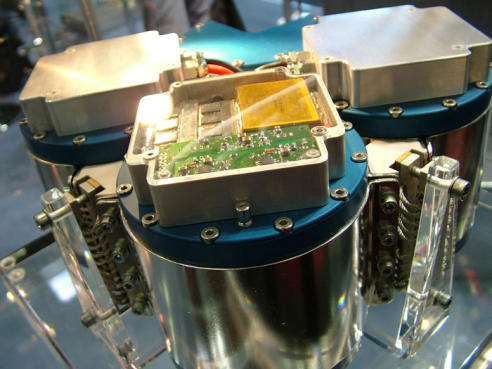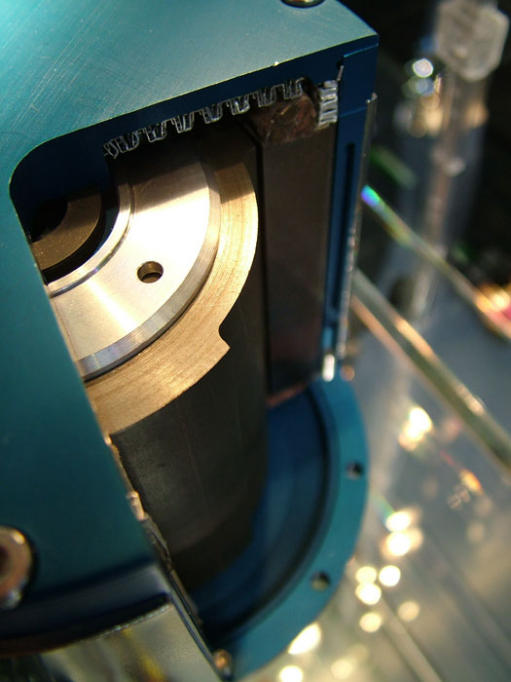Bosch selling KERS system for all forms of motorsports
 |
| Bosch four flywheel setup |
Bosch Motorsport is developing a Kinetic Energy Recovery System (KERS) for use in motor racing. With hybrid technology being used more and more in road vehicles, there are now signs that it will also find its way into racing vehicles. Bosch is developing a modular KERS kit which covers all requirements from Formula 1 to racing series such as the DTM or 24-hour races.
"In comparison with the hybrid technology of production vehicles, the concepts for motor racing are considerably more powerful, and at the same time more compact," says Klaus Böttcher, director Bosch Motorsport. "We are already holding discussions with many teams from various racing series." Depending on the specific design, the systems are intended to allow for more overtaking maneuvers using additional power that can be called upon temporarily or even to reduce the number of refueling stops by cutting consumption.
 |
| Flywheel cutaway – the rotors spin in a vacuum at up to 160,000rpm |
Hybrid systems by Bosch Motorsport always comprise a battery, the electric motor, and the KERS controller. This contains the power electronic, the battery management, and the management system for hybrid and engine functions. A lithium-ion battery with scalable capacity or a flywheel energy storage device is used for storing energy. The latter stores up to 750 kilojoules of energy. The electric motors weigh between four and eight kilograms with a maximum power level of 60 kilowatts. Thanks to its modular structure, KERS from Bosch can be put together individually in terms of weight, robustness, and performance to suit the requirements of the respective race series.
The vastly different demands of the varying classes where KERS can be used is one of the major reasons for Bosch’s modular approach, “for a 24 race application where you want to store energy at every braking event and release it immediately afterwards, like you would at Le Mans the demand are different to Formula 1 with its regulations" explains Wildner. “Around the Le Mans circuit I think you have 17 points where you brake and eight opportunities to use the boost around the lap. During the race that totals thousands of charging and discharging cycles. In Formula 1 the regulations state that you can only have one cycle per lap, no more than 78 cycles (the number of laps at Monaco). So in one world you have around 5,000 cycles per race and in the other you have just 78. So we developed this system to suit the different demands."
Like the overall system the flywheel option offers an expandable setup, “it is part of the safety concept, we are trying to keep individual rotational masses down, and to counteract the gyroscopic effect we mate pairs of flywheels, you can expand the storage system endlessly in multiples of 2" reveals Wildner. “The flywheels are basically a simple electric motor, which run at between 140,000 and 160,000rpm. You spin them up using the drive motor as a generator, and store up the electric energy as rotational energy the to boost is the opposite process and the energy is released as electricity to the motor generator."
The battery storage solution is also modular but in a more complex form as Wildner reveals; “even within the battery pack we have different options, in endurance racing we would like to have one battery last the entire season because teams have limited resources. That means that it will be a bit bigger and heavier than say a Formula 1 application where you have a system with a limited lifetime but is better in terms of size and weight. It is really about what you can afford and what you want to do.
“A high charging rate means that you may also have very high cooling demands, batteries with a low charging rate may survive with forced air cooling, high charging rates will mean liquid cooling" Wildner explains. “Mechanics will not be able to change cells trackside, though they will be able to change the module. We won’t let them work directly with the cells as they are high voltage and low inner resistance and that could have safety implications."
Bosch arranges the battery cells into modules of ten to twelve cells (see first photo above), each module is controlled by a management system which monitors the temperature, and charging state of the cells. “If the master controller sees a problem with an individual cell it can shut it down" Wildner continues.
As an experienced system and components supplier for many racing series, the experts at Bosch Motorsport have the necessary system expertise and integration know-how for motorsport applications.
Bosch Motorsport Service is part of the subsidiary Bosch Engineering GmbH, which specializes in engineering services. It can look back over a long motorsport tradition: as long ago as 1903, Bosch technology helped car racing drivers to victory for the first time.
The Bosch Group has been dealing with hybrid technologies for more than 30 years and has comprehensive expertise in battery, electrical drive, and brake management, as well as in engine management and transmission control.
